Serving 450 students in grades 7-12, Saegertown Jr. Sr. High School ranks in the bottom 50% of all schools in Pennsylvania for overall test scores (math proficiency is bottom 50%, and reading proficiency is bottom 50%).
The percentage of students achieving proficiency in math is 30-34% (which is lower than the Pennsylvania state average of 36%). The percentage of students achieving proficiency in reading/language arts is 53% (which is lower than the Pennsylvania state average of 55%).
The student:teacher ratio of 13:1 is equal to the Pennsylvania state level of 13:1.
Minority enrollment is 9% of the student body (majority Hispanic), which is lower than the Pennsylvania state average of 39% (majority Hispanic).
Quick Stats (2025)
- Grades: 7-12
- Enrollment: 450 students
- Student:Teacher Ratio: 13:1
- Minority Enrollment: 9%
- Graduation Rate: ≥95% (Top 10% in PA)
- Overall Testing Rank: Bottom 50%
- Math Proficiency: 30-34% (Btm 50%)
- Reading Proficiency: 53% (Btm 50%)
- Science Proficiency: 50-54% (Btm 50%)
- Source: National Center for Education Statistics (NCES), PA Dept. of Education
Top Rankings
Saegertown Jr. Sr. High School ranks among the top 20% of public schools in Pennsylvania for:
Category
Attribute
Graduation Rate
School Overview
Saegertown Jr. Sr. High School's student population of 450 students has stayed relatively flat over five school years.
The teacher population of 35 teachers has grown by 6% over five school years.
Grades Offered
Grades 7-12
(offers virtual instruction)
(offers virtual instruction)
Total Students
450 students
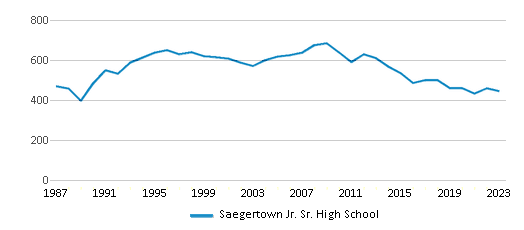
Gender %
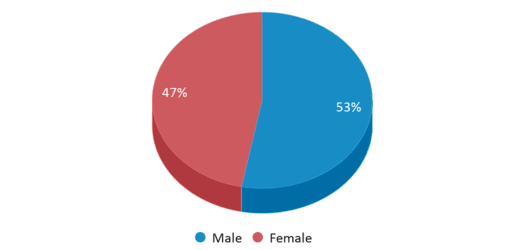
Total Classroom Teachers
35 teachers
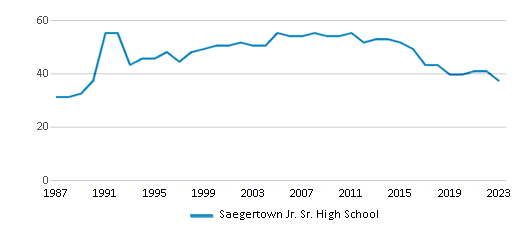
Students by Grade
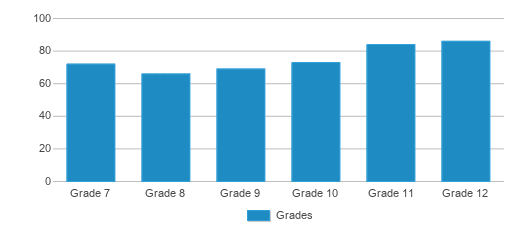
School Rankings
Saegertown Jr. Sr. High School ranks within the bottom 50% of all 2,733 schools in Pennsylvania (based off of combined math and reading proficiency testing data).
The diversity score of Saegertown Jr. Sr. High School is 0.17, which is less than the diversity score at state average of 0.59. The school's diversity has stayed relatively flat over five school years.
Overall Testing Rank
#1721 out of 2733 schools
(Bottom 50%)
(Bottom 50%)
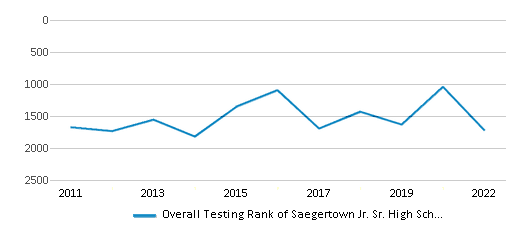
Math Test Scores (% Proficient)
30-34%
36%
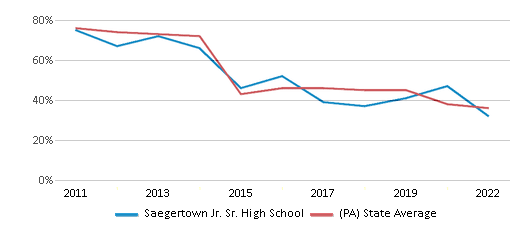
Reading/Language Arts Test Scores (% Proficient)
53%
55%
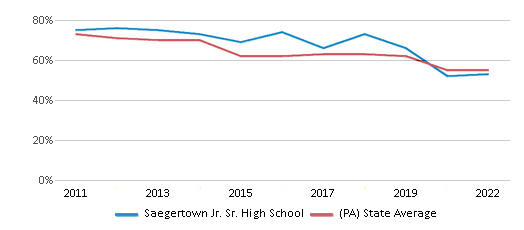
Science Test Scores (% Proficient)
50-54%
57%
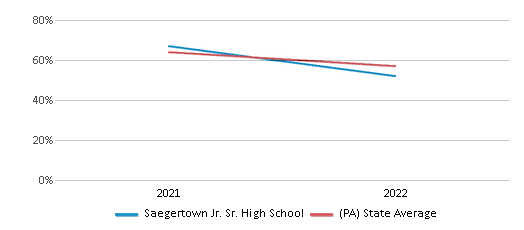
Student : Teacher Ratio
13:1
13:1
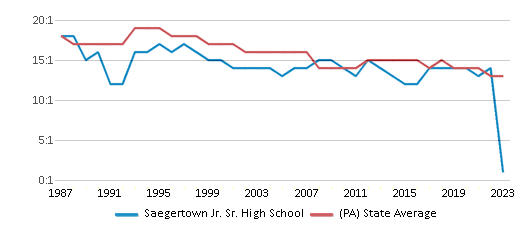
American Indian
n/a
n/a
Asian
n/a
5%
Hispanic
2%
15%
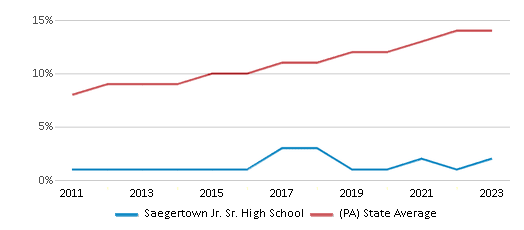
Black
1%
14%
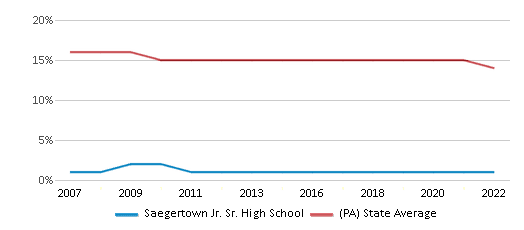
White
91%
61%
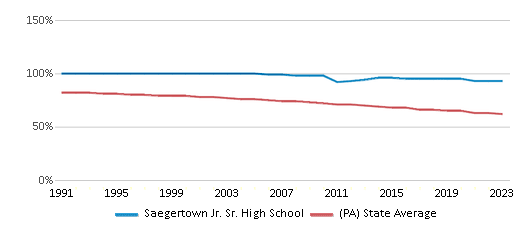
Hawaiian
n/a
n/a
Two or more races
6%
5%
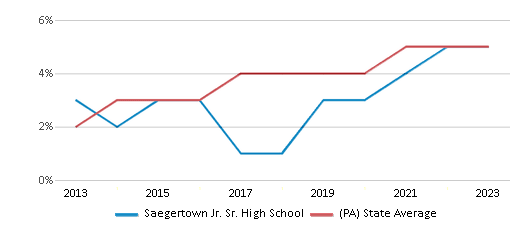
All Ethnic Groups
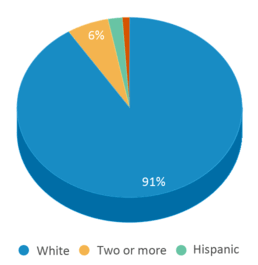

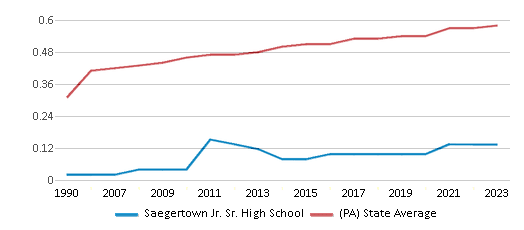
Graduation Rate
≥95%
87%
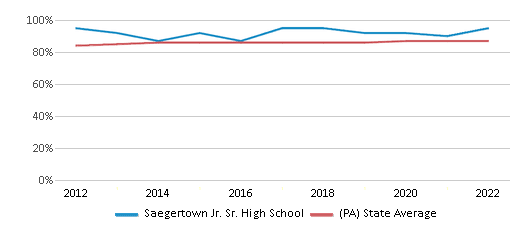
Eligible for Free Lunch
40%
60%

Eligible for Reduced Lunch
1%
2%
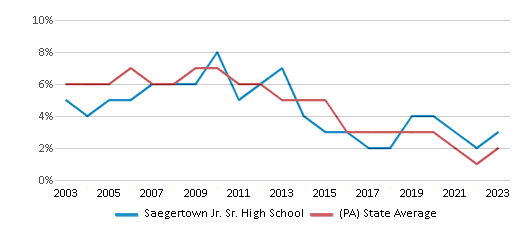
School Statewide Testing
School District Name
Source: National Center for Education Statistics (NCES), PA Dept. of Education
Profile last updated: 02/09/2025
Frequently Asked Questions
What is Saegertown Jr. Sr. High School's ranking?
Saegertown Jr. Sr. High School is ranked #1721 out of 2,733 schools, which ranks it among the bottom 50% of public schools in Pennsylvania.
What schools are Saegertown Jr. Sr. High School often compared to?
Saegertown Jr. Sr. High Schoolis often viewed alongside schools like Saegertown Elementary School, Conneaut Area Senior High School by visitors of our site.
What percent of students have achieved state testing proficiency in math and reading?
30-34% of students have achieved math proficiency (compared to the 36% PA state average), while 53% of students have achieved reading proficiency (compared to the 55% PA state average).
What is the graduation rate of Saegertown Jr. Sr. High School?
The graduation rate of Saegertown Jr. Sr. High School is 95%, which is higher than the Pennsylvania state average of 87%.
How many students attend Saegertown Jr. Sr. High School?
450 students attend Saegertown Jr. Sr. High School.
What is the racial composition of the student body?
91% of Saegertown Jr. Sr. High School students are White, 6% of students are Two or more races, 2% of students are Hispanic, and 1% of students are Black.
What is the student:teacher ratio of Saegertown Jr. Sr. High School?
Saegertown Jr. Sr. High School has a student ration of 13:1, which is equal to the Pennsylvania state average of 13:1.
What grades does Saegertown Jr. Sr. High School offer ?
Saegertown Jr. Sr. High School offers enrollment in grades 7-12 (offers virtual instruction).
What school district is Saegertown Jr. Sr. High School part of?
Saegertown Jr. Sr. High School is part of Penncrest School District.
School Reviews
5 3/3/2020
Saegertown is a wonderful school. My children currently attend, and the teachers are devoted to providing a rigorous education that will prepare students for success. For such a small school, they offer many AP classes (six or seven) and students can dual enroll in local colleges as well. Students can also attend the local career center, which offers many amazing programs. Overall, I am very happy with PENNCREST School District.
2 5/17/2016
Dress code is unnecessary; Don't get me wrong, I think it's very important, but they are now not allowing yoga pants, shorts have to be 2 inches above the knee, it's absolutely ridiculous.... Do not go to Saegertown, it's like your in a prison and have no rights.
Review Saegertown Jr. Sr. High School. Reviews should be a few sentences in length. Please include any comments on:
- Quality of academic programs, teachers, and facilities
- Availability of music, art, sports and other extracurricular activities
Recent Articles

What Is A Charter School?
Explore the world of charter schools in this comprehensive guide. Learn about their history, how they operate, and the pros and cons of this educational innovation. Discover key facts about charter schools, including admission policies, demographics, and funding, as well as what to look for when considering a charter school for your child.

10 Reasons Why High School Sports Benefit Students
Discover the 10 compelling reasons why high school sports are beneficial for students. This comprehensive article explores how athletics enhance academic performance, foster personal growth, and develop crucial life skills. From improved fitness and time management to leadership development and community representation, learn why participating in high school sports can be a game-changer for students' overall success and well-being.

February 05, 2025
Understanding the U.S. Department of Education: Structure, Impact, and EvolutionWe explore how the Department of Education shapes American education, from its cabinet-level leadership to its impact on millions of students, written for general audiences seeking clarity on this vital institution.









